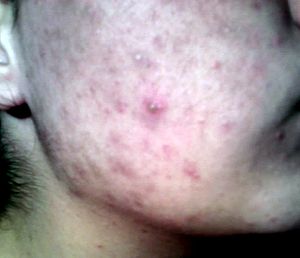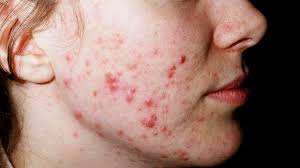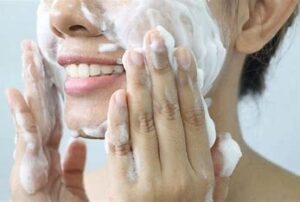
What are pimples on the face?

Pimples, often called acne or acne vulgaris, are common dermatological problems characterized by irritation or infection of the sebaceous (oil) glands.
They can appear on different parts of the body, but when they occur on the face, they are usually called facial pimples.
Pimples on the face can take several forms and may include:
Whiteheads:
Closed comedones appear as tiny, white or skin-toned bumps on the surface of the skin.
They are clogged hair follicles filled with oil and dead skin cells.
Blackheads:
Open spots manifest as small, dark-hued or blackish marks on the face of the skin.
They result from the same clogged hair follicles as whiteheads but are open at the surface, allowing the trapped material to oxidize and turn dark.
Papules:
Small, red or pink bumps that may be sensitive when touched.
These arise from inflammation of the hair follicles caused by bacterial infection.
Pustules:
Pustules resemble papules but contain pus, resulting in raised, white or yellowish lesions with a red foundation.
Nodules:
Large, painful, solid lumps that form deep within the skin. They can be red or skin-colored and often require medical treatment.
Cysts:
The most severe form of acne lesion, cysts are large, painful, pus-filled lumps that are deep within the skin. They can lead to scarring and should be treated by a healthcare professional.
Pimples can occur due to a combination of factors, including:
Excess Oil Production:
Overproduction of sebum (skin oil) by the sebaceous glands can clog hair follicles and lead to acne.
Clogged Pores:
When hair follicles become clogged with a mixture of dead skin cells, oil, and bacteria, it creates an environment where acne can develop.
Bacterial Infection:
The presence of the bacterium Propionibacterium acnes (P. acnes) on the skin can contribute to the development of pimples by causing inflammation and infection.
Hormonal Changes:
Hormonal fluctuations, such as those that occur during puberty, menstruation, pregnancy, or when using certain medications, can trigger or worsen acne.
Diet and Lifestyle Factors:
Poor dietary choices, high levels of stress, and certain cosmetics can exacerbate acne.
Genetics:
A hereditary tendency towards acne can elevate the risk of developing pimples.
Acne can manifest in varying degrees of severity; some individuals may encounter infrequent breakouts, whereas others might suffer from persistent or severe acne that necessitates medical treatment.
Effective acne treatments may include over-the-counter topical products, prescription medications, lifestyle modifications, and skincare routines tailored to your skin type and the specific type of acne you have.
If you are concerned about acne or experiencing persistent or severe breakouts, consult with a dermatologist or healthcare professional for guidance and treatment options.
Why do pimples appear on the face, and how to get rid of them?
Pimples, also known as acne or acne vulgaris, can appear on the face due to a combination of factors involving the skin’s sebaceous (oil) glands, hair follicles, bacteria, hormones, and other influences.
Here’s why pimples commonly appear on the face:
Excess Sebum Production:
Sebaceous glands in the skin produce an oily substance called sebum.
In some individuals, these glands can become overactive and produce more sebum than necessary.
Excess sebum can clog hair follicles and contribute to the development of pimples.
Clogged Pores:
Pimples often start as clogged pores. When the hair follicles become blocked with a combination of sebum, dead skin cells, and other debris, it creates an environment where pimples can form.
Bacterial Infection:
The skin is naturally populated with bacteria, including Propionibacterium acnes (P. acnes).
When hair follicles become clogged, P. acnes can proliferate and cause inflammation and infection within the follicle, leading to the development of pimples.
Hormonal Influences:
Hormonal changes play a significant role in the development of facial pimples.
During puberty, there is an increase in androgen hormones, which can stimulate the sebaceous glands to produce more sebum.
Hormonal fluctuations during the menstrual cycle, pregnancy, and menopause can also contribute to acne.
Genetics:
A family history of acne can increase the likelihood of developing pimples. Genetic factors can influence how your skin responds to hormonal changes and inflammation.
Diet and Lifestyle Factors:
Certain dietary choices and lifestyle factors can exacerbate acne in some individuals.
Consuming high-glycemic foods (like sugary and processed foods), dairy products, and excessive consumption of greasy or fried foods may contribute to acne in some cases.
Additionally, stress and inadequate skincare practices can influence acne development.
Cosmetics and Skincare Products:
Some cosmetics and skincare products, especially those that are oil-based or comedogenic (tendency to clog pores), can contribute to the formation of pimples if they block pores or irritate the skin.
Touching or Picking the Face to get rid of pimples:
Frequent touching of the face or picking at existing pimples can introduce bacteria to the skin, worsen inflammation, and lead to more pimples.
Environmental Factors:
Exposure to environmental pollutants, humidity, and certain occupational factors can affect skin health and contribute to acne development.
Age and Puberty:
Acne is particularly common during adolescence due to the surge in hormones that occurs during puberty. However, it can affect individuals of all ages, including adults.
It’s important to note that acne can vary in severity, with some people experiencing occasional breakouts, while others may have chronic or severe acne.
Effective acne management typically involves a combination of skincare practices, lifestyle modifications, over-the-counter treatments, and, in some cases, prescription medications.
If you are concerned about acne or experiencing persistent or severe breakouts, it’s advisable to consult with a dermatologist or healthcare professional for personalized guidance and treatment options.
Symptoms of pimples on the face, and how to get rid of them?
Pimples, or acne, on the face, can manifest in various forms, and the symptoms can vary from person to person.
Common symptoms and characteristics of facial pimples include:
Bumps on the Skin:
Pimples typically appear as raised bumps on the skin’s surface. These bumps may be small or large, depending on the type and severity of the pimple.
Color:
The color of a pimple can vary based on its stage of development:
Whiteheads:
Closed comedones appear as small, white, or flesh-colored bumps with no visible opening.
Blackheads:
Open comedones are small, black, or dark-colored spots with an open pore at the center. The dark color comes from oxidized sebum and debris.
Papules:
These are small, red, or pink bumps with no visible pus at the surface. They may feel tender or sore to the touch.
Pustules:
Pustules are similar to papules but have visible pus at the top, giving them a white or yellowish appearance with a red base.
Nodules:
Nodules are larger, solid, painful lumps beneath the skin’s surface.
They are often red or skin-colored and do not have a visible opening.
Cysts:
Cysts are the most severe form of acne lesion.
They are large, painful, pus-filled lumps that may be deep within the skin. They can result in scarring and significant discomfort.
Inflammation:
Many pimples, including papules, pustules, nodules, and cysts, are associated with inflammation.
Inflammation can cause redness, swelling, and tenderness around the affected area.
Pain or Discomfort:
Some pimples, especially larger and deeper ones, can be painful or uncomfortable to touch.
Itching:
Pimples and the surrounding skin may itch, especially as they heal.
Scarring:
If not properly treated or if pimples are picked or squeezed, they can leave behind scars or dark marks (post-inflammatory hyperpigmentation).
Clusters:
Pimples can appear individually or in clusters, and they may be distributed across various areas of the face.
Recurrence:
Acne can be a chronic condition, meaning that new pimples may continue to develop even as existing ones heal.
Psychological Impact:
Pimples on the face can have a significant psychological impact, affecting self-esteem and body image, particularly in cases of severe or persistent acne.
It’s important to note that while pimples are a common skin concern, they can be managed and treated effectively with proper skincare practices and, in some cases, medical interventions.
If you have concerns about face pimples or are experiencing severe or persistent acne, it’s advisable to consult with a dermatologist or healthcare professional to get rid of them.
They can provide personalized advice and treatment options tailored to your specific skin type and condition.
What causes pimples on the face, and how do we get rid of them?
Pimples, also known as acne or acne vulgaris, can develop on the face due to a combination of factors involving the skin’s sebaceous (oil) glands, hair follicles, bacteria, hormones, and other influences.
The exact causes of pimples on the face can vary from person to person, but common contributing factors include:
Excess Sebum Production:
Sebaceous glands in the skin produce an oily substance called sebum. In some individuals, these glands can become overactive, leading to excessive sebum production.
Excess sebum can clog hair follicles and contribute to the development of pimples.
Clogged Pores:
Pimples often begin as clogged pores. When the hair follicles become blocked with a combination of sebum, dead skin cells, and other debris, it creates an environment where pimples can form.
Bacterial Infection:
The skin naturally contains bacteria, including Propionibacterium acnes (P. acnes).
When hair follicles become clogged, P. acnes can proliferate and cause inflammation and infection within the follicle, leading to the development of pimples.
Hormonal Influences:
Hormonal changes play a significant role in the development of facial pimples.
During puberty, there is an increase in androgen hormones, which can stimulate the sebaceous glands to produce more sebum.
Hormonal fluctuations during the menstrual cycle, pregnancy, and menopause can also contribute to acne.
Genetics:
A family history of acne can increase the likelihood of developing pimples. Genetic factors can influence how your skin responds to hormonal changes and inflammation.
Diet and Lifestyle Factors: Certain dietary choices and lifestyle factors can exacerbate acne in some individuals.
Consuming high-glycemic foods (like sugary and processed foods), dairy products, and excessive consumption of greasy or fried foods may contribute to acne in some cases.
Additionally, stress and inadequate skincare practices can influence acne development.
Cosmetics and Skincare Products:
Some cosmetics and skincare products, especially those that are oil-based or comedogenic (tendency to clog pores), can contribute to the formation of pimples if they block pores or irritate the skin.
Touching or Picking the Face:
Frequent touching of the face or picking at existing pimples to get rid of them, can introduce bacteria to the skin, worsen inflammation, and lead to more pimples.
Environmental Factors:
Exposure to environmental pollutants, humidity, and certain occupational factors can affect skin health and contribute to acne development.
Age and Puberty:
Acne is particularly common during adolescence due to the surge in hormones that occurs during puberty. However, it can affect individuals of all ages, including adults.
It’s important to note that acne can vary in severity, with some people experiencing occasional breakouts, while others may have chronic or severe acne.
Effective acne management typically involves a combination of skincare practices, lifestyle modifications, over-the-counter treatments, and, in some cases, prescription medications.
If you are concerned about acne or experiencing persistent or severe breakouts, it’s advisable to consult with a dermatologist or healthcare professional for personalized guidance and treatment options.
How to get rid of face pimples with home remedies?
Reducing facial pimples with home remedies can be effective for mild to moderate acne.
These remedies can help control oil production, reduce inflammation, and promote the healing of existing pimples. Here are some home remedies to consider:
Regular Cleansing:

Gently wash your face twice a day with a mild, fragrance-free cleanser. Avoid harsh soaps or scrubbing, which can irritate the skin and worsen acne.
Warm Compress:
Applying a warm compress to the affected area can help reduce inflammation and encourage the pimple to come to a head. Use a clean, warm washcloth and hold it against the pimple for 10-15 minutes.
Tea Tree Oil:
Tea tree oil has natural antibacterial properties that can help reduce acne. Dilute a few drops of tea tree oil with carrier oil (like jojoba or coconut oil) and apply it to the pimple using a cotton swab.
Leave it on for a few hours or overnight.
Aloe Vera Gel:
Aloe vera has anti-inflammatory and soothing properties.
Apply a small amount of pure aloe vera gel to the pimple and leave it on for 20-30 minutes before rinsing off.
Honey and Cinnamon Mask:
Mix honey and cinnamon to create a paste and apply it to your face as a mask. Both honey and cinnamon have antibacterial properties that can help combat acne.
Apple Cider Vinegar:
Dilute apple cider vinegar with water (1 part vinegar to 3 parts water) and apply it to the pimple using a cotton ball. Leave it on for 10-20 minutes before rinsing off.
This can help reduce inflammation and kill acne-causing bacteria.
Green Tea:
Green tea is rich in antioxidants that can help soothe the skin and reduce inflammation.
Brew a cup of green tea, allow it to cool, and use a cotton ball to apply it to the affected area.
Oatmeal Mask:
Mix cooked oatmeal with honey and apply it as a mask to your face. Oatmeal can help absorb excess oil and soothe irritated skin.
Lemon Juice:
Lemon juice contains citric acid, which can help exfoliate the skin and reduce the appearance of pimples.
Apply fresh lemon juice to the pimple using a cotton swab, but be cautious, as lemon juice can be drying.
Avoid sun exposure after applying lemon juice, as it can make the skin more sensitive to UV rays.
Ice Pack:
Applying an ice pack wrapped in a clean cloth to the pimple for a few minutes can help reduce redness and swelling.
Baking Soda Paste:
Mix a small amount of baking soda with water to create a paste and apply it to the pimple.
Leave it on for 10-15 minutes before rinsing off.
Baking soda can help exfoliate the skin and reduce inflammation.
Hydration and Diet:
Stay well-hydrated by drinking plenty of water, and maintain a balanced diet rich in fruits, vegetables, and whole grains.
Avoid excessive consumption of sugary or greasy foods.
Remember that results from home remedies may vary from person to person, and what works for one individual may not work for another.
Additionally, if you have severe or persistent acne, it’s important to consult with a dermatologist or healthcare professional for a comprehensive evaluation and treatment plan.
They can recommend medical interventions, such as topical or oral medications, if necessary, to manage your acne effectively.
How to get rid of face pimples?
Getting rid of facial pimples involves a combination of proper skin care practices, lifestyle adjustments, and, in some cases, medical treatments.
Here are steps you can take to help eliminate facial pimples:
Cleanse Your Face Twice Daily:
Use a gentle, fragrance-free cleanser to wash your face in the morning and before bedtime.
Avoid harsh scrubbing, which can irritate the skin.
Avoid Overwashing:
Washing your face too frequently can strip away natural oils and worsen acne.
Stick to cleansing twice a day.
Use Non-Comedogenic Products:
Choose skincare and makeup products labeled as non-comedogenic, making them less likely to clog pores and contribute to acne.
Hands Off:
Avoid touching your face, as your hands can introduce bacteria and dirt to the skin.
Resist the urge to pick, pop, or squeeze pimples, as this can lead to scarring and further inflammation.
Moisturize:
Even if you have oily skin, use a lightweight, oil-free moisturizer to keep the skin hydrated.
Proper hydration can help balance oil production.
Spot Treatments:
Apply over-the-counter spot treatments containing ingredients like benzoyl peroxide, salicylic acid, or sulfur to the affected areas. Follow the product instructions carefully.
Prescription Medications:
If your acne is moderate to severe, consult a dermatologist who may prescribe topical or oral medications, such as retinoids, antibiotics, or hormonal treatments
Birth Control Pills:
For some individuals, hormonal birth control pills can help regulate hormones and reduce acne.
Dietary Adjustments:
Consider reducing your consumption of high-glycemic foods (sugar and processed foods) and dairy products, as some people find that these can exacerbate acne.
Focus on a balanced diet with plenty of fruits, vegetables, whole grains, and lean proteins.
Stress Management:
Practice stress-reduction techniques like meditation, yoga, or deep breathing exercises, as stress can trigger or worsen acne in some individuals.
Regular Exercise:
Engage in regular physical activity to improve blood circulation and reduce stress. Be sure to shower and cleanse your face after sweating to prevent clogged pores.
Sun Protection:
Use a broad-spectrum sunscreen with at least SPF 30 daily to protect your skin from sun damage.
Some acne medications can increase sensitivity to sunlight.
Avoid Excessive Makeup:
Limit the use of heavy makeup and try to choose products that are labeled non-comedogenic.
Be sure to remove makeup before bedtime.
Hydration:
Drink plenty of water to keep your skin hydrated from the inside out.
Consult a Dermatologist:
If you have severe or persistent acne that doesn’t respond to over-the-counter treatments or home remedies, seek professional help from a dermatologist.
They can provide personalized treatment options tailored to your specific skin condition.
It’s important to note that results may take time, and it’s essential to be consistent with your skincare routine and any prescribed treatments.
Additionally, everyone’s skin is different, so what works for one person may not work for another. Consulting with a dermatologist can help determine the most appropriate treatment plan for your specific type of acne.







